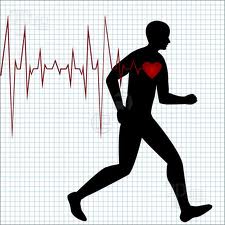 The tragic collapse of a young man just metres short of the City to Surf finish line this year, and his subsequent death, begs the questions “How, or why, did this happen?” and “Could this happen to me?”
The tragic collapse of a young man just metres short of the City to Surf finish line this year, and his subsequent death, begs the questions “How, or why, did this happen?” and “Could this happen to me?”
When word goes out that a runner has died of a heart attack, many people begin to question the wisdom of running a lot. After all, shouldn’t long distance running training make these people immune to heart disease?
I’d like to point out a few facts here:
- Shocking and tragic as it is for someone to die in a running event, the incidence of cardiac arrest during or shortly after a running event is very low.
- The biggest health problem in Australia today is definitely NOT over exercise
- Exercising does NOT make you immune to heart disease, and if you think you can exercise away the effects of a crap diet, then you are wrong!
There have been many studies on the effects of marathon racing and long distance training for running events as well as other disciplines such as triathlon and cross country skiing, and not surprisingly the results do not give us a definitive answer to the question “how much exercise is too much?”. The science does show, that overall, distance running and racing are not likely to kill you – which is little consolation to those people who in fact, it does appear to kill.
Does Exercise Damage Your Heart?
If you’ve ever raced for around the 2 hour plus mark, you wouldn’t be surprised if someone told you the race caused damage to your body. Of course it did. You can barely walk, and forget about getting on and off the loo in a hurry!
According to research published in Mayo Clinic Proceedings, the effort is also likely to have caused some damage to your heart. In the past, this damage has thought to have been only temporary, and that the heart repairs itself to its healthy state after a few weeks. However, the Mayo report shows that the damage to the heart of an endurance athlete can actually build up over time. Repeated extreme exercise, such as long distance racing – can cause a build-up of scar tissue on the heart. Scar tissue is the result of the body repairing itself, but an excessive build up of fibrous connective tissue around the heart can be dangerous. Termed patchy myocardial fibrosis, the researchers found this condition in 12% of marathon runners studied.
Dr James O’Keefe, one of the study’s, authors, says that the effects are a cumulative thing. Whilst he doesn’t say just how much exercise is the right amount, he does suggest that aiming at even three marathons a year is “not a great goal”. Exactly when heart damage starts to kick in is unknown, and will differ from person to person. In discussions with my own doctor, she has mentioned she is finding more and more (mostly) men who have been distance runners presenting with heart problems, which she acknowledges may be due to excessive exercise. A runner herself, she doesn’t make the statement lightly.
Some studies reveal up to 50% of runners, immediately after a marathon, show increased levels of enzymes and biomarkers that are traditionally released during a heart attack. The actual incidence of people suffering a heart attack during or immediately after a marathon is pretty small, however, so what’s going on? Other researchers have suggested that these biomarkers are being released from skeletal muscle, rather than the heart.
So who’s right?
The biggest study of cardiac arrests and deaths in marathons and half marathons is the RACER study (Race Associated Cardiac Arrest Registry). This study concluded that “Long distance running races are associated with low overall risk of cardiac arrest and sudden death.”
The authors show that rates of cardiac arrest in distance runners are lower than those in 18-22 year olds involved in college sports, lower than those involved in triathlons, and similar to those amongst healthy joggers and “avid recreational exercisers” “The risk associated with long distance running events is equivalent to or lower than the risk experienced in other vigorous physical activity.”
The lead author of the RACER study is cardiologist Aaron Baggish, who also happens to be a keen runner with a marathon PB of 2:49. The study tracked 10.9 million runners who participated in marathons and half marathons from January 2000 to May 2010. Out of these 10.9m runners, the study found 59 “cardiac arrests,” defined as a fallen, unconscious runner with no discernible pulse. Seventeen of these runners were subsequently resuscitated and survived, while 42 died.
The Results
- The rate of cardiac arrests in marathons was found to be about 4 times that of half marathons, leading researchers to believe the marathon distance fatigues the heart more
- The risk of having a heart attack in a marathon is 1.01 per 100,000 participants
- The death risk from heart attack in a marathon is .63/100,000.
- On these figures, big marathons would expect one heart attack for every 99,000 runners, and one death for every 158,000 runners.
- The highest risk group was men running marathons, with a cardiac-arrest incidence of 1.41/100,000, or one per 70,900 runners.
- Men have about a five times higher risk than women for both heart attacks and death.
- Hyponatremia (low blood sodium level usually caused by drinking too much water) and heat stroke are “uncommon causes” of heart attack and death
- Aspirin probably doesn’t reduce heart attacks in runners
- Most cardiac arrests occur in the last 6 miles of the marathon and last 3 miles of the half-marathon.
- The 71% death rate among the cardiac-arrest runners is considerably lower than the 92% death rate for similar out-of-hospital events, probably due to the large number of medical teams at the finish, and the likely quick access to a defibrillator.
The study was able to look at clinical information for 31 of the 59 runners who suffered cardiac arrest. The clinical information showed:
- No evidence of dislodged plaque in autopsies of those who had cardiac arrests. The belief had previously been that middle-aged men suffered exercise heart attacks when a chunk of cholesterol plaque broke free from an artery and lodged elsewhere.
- Autopsies found signs for what is called “demand ischemia” which basically means that more oxygen was needed than could be supplied. This might speak to the high percentage of heart attacks that occur near the finish line of races, rather than along the course. If you already have a fatigued heart and you suddenly break into a sprint that requires more oxygen, you might be pushing your heart past the point of no return!
- The study found the biggest cause of cardiac arrests and deaths was “definite/probable hypertrophic cardiomyopathy.” This is a mostly genetic condition believed to be the cause of many of the cardiac arrests among young athletes (under age 35) in all sports.
- If you are younger than 35, and suffer a heart attack while running, you are more likely to have a tough-to-resuscitate cardiomyopathy than the slightly less serious ischemic heart disease.
- Eight out of 8 survivors (100 percent) in this clinical-information subgroup received CPR on the course. Among non survivors, only 43 percent received CPR.
- There has been an increasing risk of heart attacks amongst male runners in the last five years (2005-2010) vs 2000-2004. The authors felt this could be a result of more high-risk men with hidden cardiac disease taking up running, in the hope of seeing health benefits
What are we to make of all this?
Well, firstly, not very many people die doing a marathon or half marathon.
Secondly, no-one every climbed Mt Everest for their health. I don’t say this flippantly. I just mean if you want to challenge yourself, there will be some risks, but there are things you can do to minimise those risks.
Reducing Your Risk of a Running Related Heart Attack
Whilst statistics show that the overall risk of anyone dying in a marathon or half marathon is low, you can reduce your individual risk factor in a number of ways
- Move frequently. Sitting at a desk all day and then getting a dose of exercise is not optimal for your health. Getting a dose of vigorous exercise is no more important for your health than moving regularly throughout the day. And by regularly, I mean don’t sit for longer than 30 mins at a time – and better still, not more than 20 minutes.
- Don’t sprint at the end of a long distance race, particularly if you are not trained to do so. You are far more likely to suffer from an ischemic attack if your already fatigued heart cannot get enough oxygen in due to you being a hero
- Break up your training to give your heart a rest. Don’t train for long distance events year round. Train in several blocks per year. You might spend 6-10 weeks twice a year training for shorter races such as 5 or 10kms, and slot your longer distance training blocks between these.
- Be sensible about the number of longer races you race each year. If you’re truly pushing yourself during the race, and you do a lot of training to prepare for the race, one marathon in a 12 months period might be enough, and two half marathons should be the limit.
- In order to find out if your heart has scarring or damage, you could get an MRI, CT scan or echocardiogram – but that’s a bit full on
- Get adequate sleep. For adults this is between 7 and 9 hours per night.
- Don’t race if you’re not up to it. You can still participate in the run, without actually racing it. Sometimes, you have to accept that you’re underdone, and ease back a bit.
- Eat a healthy, balanced and varied diet, which includes junk food only very occasionally. No amount of physical activity can make up for a crap diet.
Signs of Heart Attack
If you compete in distance events, you need to be aware of, and monitor yourself for, signs of heart problems. Warning signs include:
- chest discomfort or squeezing
- throat tightness
- pain that radiates into the jaw or left arm
- unusual tiredness that can’t be put down to an increased training load or lack of sleep
- recent infection (not in itself a sign of heart problems, but it could put more load on your heart)
- unexplained drop off in performance which you can’t put down to over training could indicate something is wrong with your hear
- sudden heart palpitations
Of course it’s possible to experience some or all of the above signs and symptoms, and have absolutely no problems with your heart, but if something doesn’t seem quite right, ask your doctor to check it out.
You should be particularly aware of any kind of discomfort in your chest which appears during exercise, then stops afterwards. Angina frequently does not present as sharp pain. Symptoms include squeezing sensations in the chest, and feelings of pressure or chest tightness.
It’s likely that many people who suffer a heart attack actually had a fair number of warning signs in the weeks leading up to the incident, but they either didn’t know what to look out for, or shrugged it off as unimportant.
If you think there’s something wrong, there usually is, so do something about it.
Having said that, I once underwent a series of tests for my heart as I was experiencing pain in my chest, down my left arm and into my jaw when running. The pain would stop as soon as I stopped running. I was pretty sure there wasn’t anything seriously wrong, as I happened to be wearing a heart rate monitor a couple of the times it happened, and there was no change in my heart rate during these episodes. None the less, I had it checked out. After wearing a heart monitor for 24 hours, and having lots of pictures taken of my heart, I had a good massage around my shoulder area and the pain disappeared. It was rather what I suspected, but I would have felt a dreadful fool if I hadn’t had it checked out and had a heart attack on the massage table!


